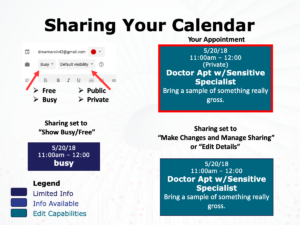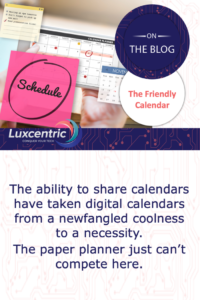The Friendly Calendar
How much time do you spend coordinating schedules with other people?
How much frustration do you endure because of last-minute schedule conflicts, forgotten appointments, or the need to go check a calendar that is not with you when you need it?
The ability to share calendars have taken digital calendars from a newfangled coolness to a necessity. The paper planner just can’t compete here.
In modern digital terminology, a shared calendar is a calendar that two or more people have access to using different calendar logins. You can share the entire calendar, the calendar with limited information or just a single event in the calendar.
While technically accurate, sharing a calendar by having everyone use the same login information is not a shared calendar in the modern digital calendar sharing sense.
The ways of sharing
When sharing calendars there are a few things to consider and some unfortunate realities.
Unfortunate Reality:
Brand matters. Gmail likes to share only with Gmail and Microsoft only with Microsoft and so on. iCal sort of shares with everyone, but there are serious issues.
Things to consider:
Email account matters. When you invite someone to your calendar it is a good idea to make sure you are using the email attached to the calendar system they are using for their primary calendar. This makes it easier for them to view your calendar in relation to their calendar. And when you ask someone to share their calendar with you, make sure you give them the email address your primary calendar is attached to.
A real calendar sharing situation can be as simple as sharing free or busy times to a complete trust in allowing the other members to add and delete appointments on the shared calendar.
To share a personal calendar you will need to visit the settings for your calendar. From settings you can choose just how much of your calendar you wish to share and with whom.
- You can share everything, including the ability to edit and change appointments.
- You can share just visibility of your appointments
- You can share just your free and busy times.
Public and published calendars

Free/Busy:
There are things on our calendars that are optional or can be moved around. You can identify these appointments by selecting either free or busy. When you do this you can share your calendar in a private way and your invitee will only see blocked out times on your calendar if you opted to share only free and busy times.
Visibility:
Public or private, some appointments are ok to be shared with everyone and others are of a more private nature and only the date, time and duration are necessary to divulge, this distinction can also be set in the calendar. This allows you to let your people know about some things and keep others private when you share the calendar.
Be aware, when you share a calendar and give the invitee the ability to “share and make changes” then your private/public options are generally not considered.
Published Calendars:
A calendar you can subscribe to is often a public calendar that is usually read-only. A few examples are the US holiday calendar or the calendar your favorite team publishes.
Event Invitations
You do not need to share calendars to coordinate events.
You can “invite” someone, anyone else with a digital calendar, or an email address, to your appointment and they can “invite” you. You don’t need to share an entire calendar for this, but you are sharing an appointment within your calendar. In a digital situation your calendar will be tied to an email address and if everything is set up correctly shared appointments will just “show up” on the calendars and can be accepted or rejected as needed.
See you around the Internet,
Nicole


